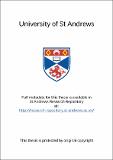Files in this item
From roots to rites : practice logics and the 'heir' to metaphysics
Item metadata
| dc.contributor.advisor | Partridge, Michael Francis | en |
| dc.contributor.author | Rawnsley, Andrew C. | en |
| dc.coverage.spatial | viii, 311 p 30 cm. | en |
| dc.date.accessioned | 2021-04-08T08:57:20Z | |
| dc.date.available | 2021-04-08T08:57:20Z | |
| dc.date.issued | 2006 | |
| dc.identifier.uri | https://hdl.handle.net/10023/21872 | |
| dc.description.abstract | One of the prevalent themes in recent theologies and philosophies of religion, especially those with a sensitivity to continental philosophy and theory more broadly, has been the problem of 'metaphysics'. This thesis seeks to explore the possibility of theology in a post-metaphysical mode. One of the main issues is whether theology requires some sort of framework for its articulation which can be characterized as having metaphysical-like features. This framework we call the 'heir' to metaphysics. The problem of metaphysics also appears within two, on the surface, quite different problems for theology: that of the relation of different 'domains' or 'spaces' (such as 'Church' and 'world', 'sacred' and 'profane', 'religious' and 'secular'); and this latter issue is also involved with the common view that human beings perceive and organize their world in terms of 'worldviews' or 'schema'. This thesis sets out to challenge both of these ideas. But unlike many previous attempts to work in a 'post-metaphysical' mode, the 'heir' to metaphysics is one which seeks to emphasize three distinct aspects, often previously overlooked: firstly, the embodied situated character of all human doing and thinking. This is explored through a re-exploration of the phenomenological tradition, not least because much of the impetus for 'post-metaphysical' theology has come from the so-called 'theological turn' of French phenomenology, such as Jean-Luc Marion and Jean-Yves Lacoste, both of whose work is examined in this thesis. We suggest that it is Maurice Merleau-Ponty whose philosophy offers the best place to re-think phenomenology, however, rather than these more recent approaches. Secondly, this situated character of human doing and thinking is organized by way of human practices: this praxeological turn is explored primarily through the work of Pierre Bourdieu and Theodore Schatzki. Thirdly, the implications of a recursive or dialectical structure to human situatedness which both Bourdieu and Schatzki emphasize, and which is articulated through practices, is extended into a topology, a redefinition of traditional ontology which is capable of taking account of the complexity and interwoven character of human life. It is this topology that is the principal organizing feature of the 'heir' to metaphysics. We then set out what this topology might be like through an exploration of the shape of what we call, following Barry Smith and Jan Patocka, the 'mesoscopic' world. By focussing on a conceptual distinction between 'situational practices' and 'practices of thematization' suggestions of new ways of thinking about the structure of human situations arise. Flow such an 'heir' might interact with theology and religious practices more broadly is the focus of the latter part of the thesis. This is done through examining 'ritualization' as a practice which is common within religious communities. How such ritualization practices are conceptualized in a particularly Christian way is explored through the sacramental theology of Louis-Marie Chauvet and through the tradition of liturgical theology typified by Alexander Schmemann, whose notion of leitourgia is used to broaden out how we might speak about situated mesoscopic experience in a theological way without opposing Church and world, sacred and profane, or the religious and the secular. | en |
| dc.language.iso | en | en |
| dc.publisher | University of St Andrews | en |
| dc.subject.lcc | BT55.R2 | |
| dc.subject.lcsh | Philosophical theology | en |
| dc.subject.lcsh | Metaphysics | en |
| dc.subject.lcsh | Phenomenology | en |
| dc.title | From roots to rites : practice logics and the 'heir' to metaphysics | en |
| dc.type | Thesis | en |
| dc.type.qualificationlevel | Doctoral | en |
| dc.type.qualificationname | PhD Doctor of Philosopy | en |
| dc.publisher.institution | The University of St Andrews | en |
This item appears in the following Collection(s)
Items in the St Andrews Research Repository are protected by copyright, with all rights reserved, unless otherwise indicated.

